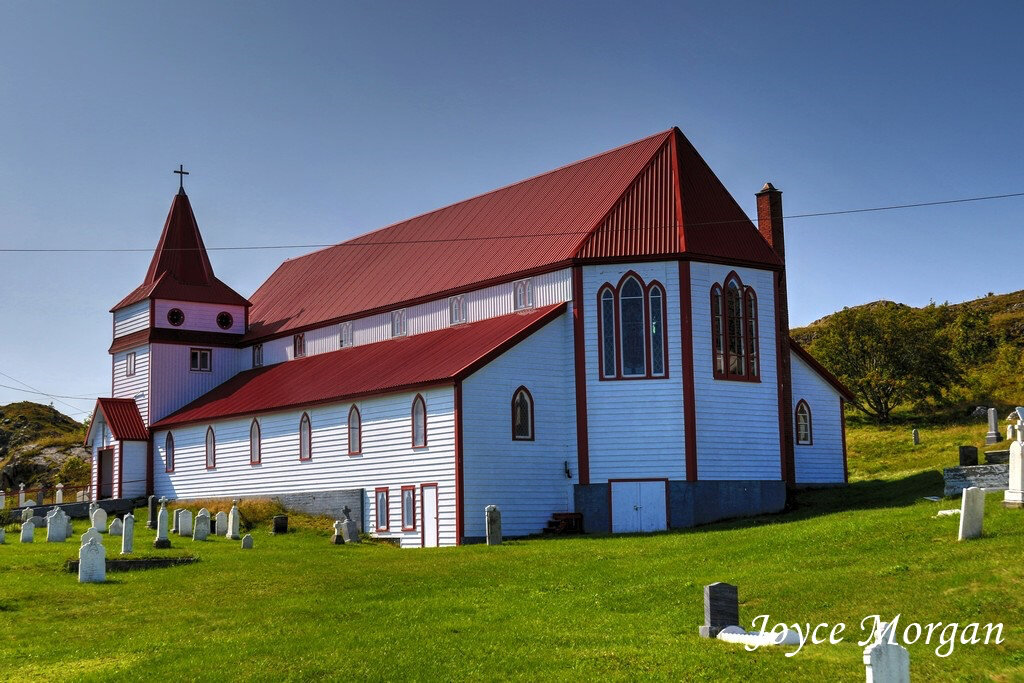
Churches & Graveyards
In a place where so many souls set out on stormy seas
it is understandable that faith has been an important part of Port de Grave history.
Port de Grave’s rich history of faith is reflected in its numerous churches and graveyards, representing diverse belief systems and countless stories of resolve, resilience, and rectitude.
St. Luke’s Church
The first Church of England church in Port de Grave, work began on St. Luke’s in 1823, was completed in 1826, and the church was consecrated by Bishop John Inglis in July of 1827. It was built on land purchased from the Dawe family and was located on the hill behind the present church hall. 1827 was also the year the first clergyman, Rev. Charles Blackman, arrived at Port de Grave.
This church was replaced by a new, larger church in 1873. A bell was installed around 1885 in a belfry close to the road.
In 1916 it was decided to build the present church, which is 100 feet long and was originally designed to seat 1,000 people. A very tall tower (shortened in 1949) was built on the church to house the bell. It took 10 years to build this church due mainly to years of poor fishery and the large number of young men (41) serving in the Armed Forces during World War I.
The church was finished and consecrated by Bishop White in 1926. It continues to serve the people of Port de Grave today.
St. Mark’s Anglican Church
St. Mark’s was built in 1816 by a community of fishermen and their families. Referred to as the “Free Labour Church” at the time, it was consecrated on May 14, 1930 by Bishop White.
St. Mark’s Church is one of the most prominent buildings on the Peninsula. The approaches along Bareneed Road and Otterbury Road offer striking views of the church and surrounding grounds set against a transfixing vista. St. Mark’s Church was closed shortly after celebrating its 200th anniversary in 2016.
The United Church of Canada
The United Church of Canada had two churches on the Port de Grave Peninsula, one at the fork in the road in Bareneed and the other by the harbour. There was also a one-room school which was open until the early sixties, when the remaining eight students went to St. Luke’s and the Pentecostal School in Ship Cove. Due to declining attendance numbers, both churches eventually closed and the schoolhouse was torn down.
At the site of the United Church in the harbour you will find the old bell and monument. The church bell in Bareneed can be found in the cemetery. Even though the churches are closed, the cemeteries are still being used and taken care of by former members of the congregation.
Pentecostal Tabernacle
The first Pentecostal activity on the Peninsula took place in the form of open-air meetings on a local fisherman’s wharf in 1924, with visiting Pentecostals presiding to share with others information about their faith. The first official service was held at the Orange Lodge in March 1925, continuing there and in private homes until a new church was opened on April 2, 1926.
The first Pentecostal school in the community opened in 1955, and on May 26, 1963, a new church was opened by Ship Cove Pond. It became a lively site in the early 1970s, when pastors Robert and Phyllis Simmons placed a greater emphasis on music. Later that decade, a television program born through the ministry of pastors William and Taffie Burton began to air on NTV. “Joyful Sound” was broadcast across the province for a few years and considered a great success for the church.
Two years after a new Pentecostal school opened on the Harbour Hills in 1985, a new church was built adjacent to the school. It officially opened on April 19, 1987. When the Pentecostal school closed in the late 1990s, the Church purchased the building to use as a ministry centre.
Graveyards
Explore the over 40 graveyards dotted along the Peninsula to research your ancestors or see the many names familiar to those from Devon, Cornwall, and Ireland. You will find headstones dating back to the early 1800s.








